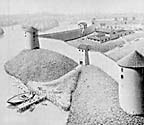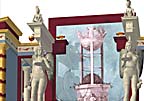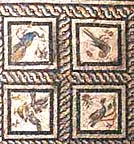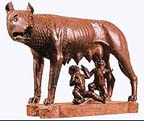 Bulgarian archeologists believe they may have found one of the most famous oracles of antiquity, a Thracian temple of Dionysus, in the mountains of southern Bulgaria. Combing through the site of the ancient village of Perperikon in the Rhodope mountain chain, archaeologists found an oval hall that had no roof but a round altar carved out of the rock. This matches a description of the oracle by the Roman historian Suetonius. Nikolai Ovtcharov, the head of the archeology team, pointed out that this sanctuary is as important as that of Apollo at Delphi, "It is where Alexander the Great heard before he embarked on his conquest of Asia that he would become master of the world."
Bulgarian archeologists believe they may have found one of the most famous oracles of antiquity, a Thracian temple of Dionysus, in the mountains of southern Bulgaria. Combing through the site of the ancient village of Perperikon in the Rhodope mountain chain, archaeologists found an oval hall that had no roof but a round altar carved out of the rock. This matches a description of the oracle by the Roman historian Suetonius. Nikolai Ovtcharov, the head of the archeology team, pointed out that this sanctuary is as important as that of Apollo at Delphi, "It is where Alexander the Great heard before he embarked on his conquest of Asia that he would become master of the world."
Subsection of Roman Times:
Articles about current archaeology and research into the remains of Roman and Byzantine civilizations.
Sunday, May 25, 2003
Temple of First Oracle to Proclaim Alexander Ruler of the World Found in Bulgaria
 Bulgarian archeologists believe they may have found one of the most famous oracles of antiquity, a Thracian temple of Dionysus, in the mountains of southern Bulgaria. Combing through the site of the ancient village of Perperikon in the Rhodope mountain chain, archaeologists found an oval hall that had no roof but a round altar carved out of the rock. This matches a description of the oracle by the Roman historian Suetonius. Nikolai Ovtcharov, the head of the archeology team, pointed out that this sanctuary is as important as that of Apollo at Delphi, "It is where Alexander the Great heard before he embarked on his conquest of Asia that he would become master of the world."
Bulgarian archeologists believe they may have found one of the most famous oracles of antiquity, a Thracian temple of Dionysus, in the mountains of southern Bulgaria. Combing through the site of the ancient village of Perperikon in the Rhodope mountain chain, archaeologists found an oval hall that had no roof but a round altar carved out of the rock. This matches a description of the oracle by the Roman historian Suetonius. Nikolai Ovtcharov, the head of the archeology team, pointed out that this sanctuary is as important as that of Apollo at Delphi, "It is where Alexander the Great heard before he embarked on his conquest of Asia that he would become master of the world."
Etruscan Gold Book Surfaces in Bulgaria
An Etruscan gold book containing six 23.82-carat gold pages covered with ancient text and depicting images of warriors and a siren has been donated to the Bulgarian National Museum of History by an anonymous benefactor. The text and the images indicate the book was made for the funeral of an aristocrat who was a member of the Orpheus cult.
The Greek philosopher Pythagoras influenced by orphism--a Thracian religion--spread its ideas in ancient Greek cities in southern Italy and the neighboring territories of Etruscan tribes. Bulgarian Professor Valdimir Geogiev is working to decipher the text.
The Greek philosopher Pythagoras influenced by orphism--a Thracian religion--spread its ideas in ancient Greek cities in southern Italy and the neighboring territories of Etruscan tribes. Bulgarian Professor Valdimir Geogiev is working to decipher the text.
Police fingerprint expert helps track the work of a 1st Century Roman potter
Ceramics specialist at the Museum of London, Charlotte Thompson, approached David Goodwin, head of Northamptonshire Polices Fingerprint Bureau for help after discovering prints on ancient Roman relics. Thompson hoped to discover whether the pottery had been made by one person, or by a group of potters working under a single name.
"It was very interesting for me to look at such an old item and broaden my experience of the history of fingerprints," Goodwin remarked. "The oldest fingerprints I knew of previously dated back to the 16th Century."
He studied images of the nine pieces of pottery, but was unable to determine how many people were involved in making the items.
"Because the detail on the marks is quite poor, all we can say is that on two of the pieces, the prints looked similar," Goodwin said.
"It was very interesting for me to look at such an old item and broaden my experience of the history of fingerprints," Goodwin remarked. "The oldest fingerprints I knew of previously dated back to the 16th Century."
He studied images of the nine pieces of pottery, but was unable to determine how many people were involved in making the items.
"Because the detail on the marks is quite poor, all we can say is that on two of the pieces, the prints looked similar," Goodwin said.
Ancient Rome Another Venice
"The dynamic nature of the Tiber, the extent to which it rises and falls, asserts Professor Albert Ammerman of Colgate University in New York, "Since the modern embankment was built in the late 19th century the river has been channelled. But in fact it can go from three metres above sea level to between eleven and thirteen metres. This means it would have flooded the Velabrum regularly, creating an effect in Rome not unlike the acqua alta of Venice."
Professor Ammerman continues, "A traveller approaching Rome in the Republican era--say at the time of the Punic Wars--would have seen an astonishing sight: the Temple of Jupiter towering above him on Capitol Hill, but also a line of other great temples on the river bank, appearing to rise out of the water."
Professor Ammerman continues, "A traveller approaching Rome in the Republican era--say at the time of the Punic Wars--would have seen an astonishing sight: the Temple of Jupiter towering above him on Capitol Hill, but also a line of other great temples on the river bank, appearing to rise out of the water."
Culture Ministry plans to exhibit artifacts from Nicopolis
 Founded by Octavian after his triumph in the Battle of Actium in 31 BC and decisive defeat of his opponents, Mark Antony and Cleopatra. Nicopolis, the city of Nike, or Victory, developed over the next 10 centuries into the leading urban center in northwestern Greece. The inhabitants of the neighbouring cities of Epirus, Leucas, and Acarnania were forced to settle in this area. The city enjoyed special political and financial privileges, had its own mint and every four years celebrated the Actia, festivals including athletic, musical and racing contests. Many intellectuals of the period, such as Epictetus (A.D. 89) gathered in Nikopolis. The city was sacked by the Goths in the fourth century then restored by Justinian in the fifth century. It was inhabited through the Byzantine period.
Founded by Octavian after his triumph in the Battle of Actium in 31 BC and decisive defeat of his opponents, Mark Antony and Cleopatra. Nicopolis, the city of Nike, or Victory, developed over the next 10 centuries into the leading urban center in northwestern Greece. The inhabitants of the neighbouring cities of Epirus, Leucas, and Acarnania were forced to settle in this area. The city enjoyed special political and financial privileges, had its own mint and every four years celebrated the Actia, festivals including athletic, musical and racing contests. Many intellectuals of the period, such as Epictetus (A.D. 89) gathered in Nikopolis. The city was sacked by the Goths in the fourth century then restored by Justinian in the fifth century. It was inhabited through the Byzantine period.
The Culture Ministry has made plans to exhibit thousands of artifacts unearthed there, including sculptures, mosaics and lamps. The first systematic excavations on the site were carried out in the period 1913-1926, by the Archaeological Society, under the direction of Al. Philadelpheus, and were continued by professors G. Soteriou and A. Orlandos until 1938. A British team from the University of Nottingham have been working at the site since 1996.
See also: http://www.nottingham.ac.uk/archaeology/research/balkans/bulg/bcity.html
Roman Stage Sets Recreated Virtually at University of Warwick
 The remains of Pompeiis ancient villas show that the Romans decorated their villas with extravagant wall paintings of theatre scenes that used tricks of perspective to impress guests with what seemed at the time an early version of virtual reality. Now, researchers at the University of Warwick are transforming these ancient forms of perspective painting into the 21st century version of virtual reality using 3-D digital models that allow viewers to tread the boards of long-lost Roman theatres.
The remains of Pompeiis ancient villas show that the Romans decorated their villas with extravagant wall paintings of theatre scenes that used tricks of perspective to impress guests with what seemed at the time an early version of virtual reality. Now, researchers at the University of Warwick are transforming these ancient forms of perspective painting into the 21st century version of virtual reality using 3-D digital models that allow viewers to tread the boards of long-lost Roman theatres.
Drew Baker, from e-lab at the University of Warwick, said: "Theatre was an integral part of Roman culture and the wall paintings enable us to understand theatre, politics and culture during the transition from Republic to Empire. The new virtual theatre museums open up new possibilities, and are more engaging than conventional museums. Until now, museum visitors were expected to appreciate the art and history of the theatre by examining static displays, miniature stage sets, and two-dimensional photographs or drawings."
Thursday, May 15, 2003
1st Century Jewish Catacombs Near Venosa, Italy Continue to Yield Evidence of Roman Captivity
 Newly uncovered catacombs near Venosa, Italy are yielding artifacts from a settlement of Jewish prisoners brought to Italy in the first century C.E. Dr. Cesare Colafemmina, visiting professor of Hebrew and Hebraic literature at the University of Calabria, said documents indicate that Emperor Titus brought 5,000 captives to the region after the destruction of the Second Temple in Jerusalem in A.D. 70. Hundreds more are thought to have settled here before and after that time, simply because it was a prosperous crossroads of maritime trade. And Jews played a vital role in Mediterranean commerce. By the end of the fourth century many towns were dominated by Jews. They even became political and community leaders, he added.
Newly uncovered catacombs near Venosa, Italy are yielding artifacts from a settlement of Jewish prisoners brought to Italy in the first century C.E. Dr. Cesare Colafemmina, visiting professor of Hebrew and Hebraic literature at the University of Calabria, said documents indicate that Emperor Titus brought 5,000 captives to the region after the destruction of the Second Temple in Jerusalem in A.D. 70. Hundreds more are thought to have settled here before and after that time, simply because it was a prosperous crossroads of maritime trade. And Jews played a vital role in Mediterranean commerce. By the end of the fourth century many towns were dominated by Jews. They even became political and community leaders, he added.
Historians were surprised that inscriptions on the burial slabs found to date are almost totally in Greek. There is little or no Hebrew. When Hebrew is used, the characters mostly spell out Greek or Latin words. Both Greek and Latin were commonly used in that part of Italy at the time. This suggests an assimilated life for the Jews who may have lived here outside Venosa between the third and seventh centuries A.D.
Monday, May 12, 2003
Intellectual Center of 6th Century Alexandria Uncovered
 Monumental red-brick baths dating from the fourth century with an adjoining cistern, and a small theatre with marble tiers of the same period have been found by a Polish team at Kom Al-Dikka near Alexandria. Both buildings opened to the west into a large open space lined with columns, the agora of late antique Alexandria. Residences of the wealthy inhabitants of the city lined the streets originally laid down by Alexander and his heirs, and while the houses of the earlier Ptolemaic period are hardly accessible, the later ones, with wall paintings and fine mosaic floors have been preserved, and, as in the third century Roman "Villa of the Birds" discovered earlier, restored. During the sixth century, the eastern side of the agora underwent reconstruction and a succession of meeting rooms were built within the colonnade. The theatre was also transformed: a dome was constructed over the tiers of steps, thus creating a huge lecture hall in line with the smaller rooms.
Monumental red-brick baths dating from the fourth century with an adjoining cistern, and a small theatre with marble tiers of the same period have been found by a Polish team at Kom Al-Dikka near Alexandria. Both buildings opened to the west into a large open space lined with columns, the agora of late antique Alexandria. Residences of the wealthy inhabitants of the city lined the streets originally laid down by Alexander and his heirs, and while the houses of the earlier Ptolemaic period are hardly accessible, the later ones, with wall paintings and fine mosaic floors have been preserved, and, as in the third century Roman "Villa of the Birds" discovered earlier, restored. During the sixth century, the eastern side of the agora underwent reconstruction and a succession of meeting rooms were built within the colonnade. The theatre was also transformed: a dome was constructed over the tiers of steps, thus creating a huge lecture hall in line with the smaller rooms.
See also: http://www.guardians.net/sca/roman_mosaics.htm
Monday, May 05, 2003
Stesichorus claims a woman founded Rome
 According to Romes Il Messaggero newspaper, a fragment of writing by the Graeco-Sicilian poet Stesichorus (638-555 BC) recounts how a woman named Roma arrived with a Trojan fleet in an idyllic place that could easily be Rome. The scene was described as one of enchanting beauty, where before the setting sun the visitor was "enticed to dream while being caressed by the off-shore breeze".
According to Romes Il Messaggero newspaper, a fragment of writing by the Graeco-Sicilian poet Stesichorus (638-555 BC) recounts how a woman named Roma arrived with a Trojan fleet in an idyllic place that could easily be Rome. The scene was described as one of enchanting beauty, where before the setting sun the visitor was "enticed to dream while being caressed by the off-shore breeze".
Roma fell so in love with the spot that she conspired with the other women to burn all the ships, so that the party would have to stay. Once they were stranded, the group all agreed that they should name the place after her.
The tales claims are strengthened by the fact that Stesichorus was born just 115 years after the founding of Rome.
See also: http://www.anotherscene.com/phaedrus/stesic.html
Two Roman Forts Discovered near Dine-fwr Park in Llandeilo, Wales
Ground-penetrating surveys carried out by Cambrian Archaeology, has revealed two Roman forts plus a range of roads, buildings and streets near Dine-fwr Park in Llandeilo, Wales. The square or rectangular fort, which was built around 70 AD, is overlain by a smaller rectangular fort, which was built when the area was reoccupied some years later.
"The first of the forts, the largest of the two, was abandoned soon after it was built. But the second similar fort, which gives a more complete image, is packed with streets and buildings. Early indications also show that there was a bath house, which was a popular and very advanced means of relaxing for the Romans," explains Gwilym Hughes, director of Cambria Archaeology. "The earliest fort is huge and covers nearly four hectares - more than nine acres - the largest in Wales outside the Roman regional headquarters at Caerleon. This suggests a much greater scale of resistance to the Roman invasion than previously recognised by historians. It indicates that the local Demetae tribe did not meekly accept Roman rule. It was not the walkover that has previously been implied."
"The first of the forts, the largest of the two, was abandoned soon after it was built. But the second similar fort, which gives a more complete image, is packed with streets and buildings. Early indications also show that there was a bath house, which was a popular and very advanced means of relaxing for the Romans," explains Gwilym Hughes, director of Cambria Archaeology. "The earliest fort is huge and covers nearly four hectares - more than nine acres - the largest in Wales outside the Roman regional headquarters at Caerleon. This suggests a much greater scale of resistance to the Roman invasion than previously recognised by historians. It indicates that the local Demetae tribe did not meekly accept Roman rule. It was not the walkover that has previously been implied."
Pliny the Elder inspires resurrection of Pompeiian wine
 In a walled vineyard in the shadow of Pompeiis splendid amphitheatre, Pietro Mastroberardino has produced a wine which is "very intense and with a nice fruity bouquet" from the original vines grown within the walls of the ancient city. "We used different techniques but the same technology, and for the nose and the mouth this has the same result," said the winemaker.
In a walled vineyard in the shadow of Pompeiis splendid amphitheatre, Pietro Mastroberardino has produced a wine which is "very intense and with a nice fruity bouquet" from the original vines grown within the walls of the ancient city. "We used different techniques but the same technology, and for the nose and the mouth this has the same result," said the winemaker.
The ancient imbibers who kept Pompeiis more than 200 wine bars busy often diluted their favourite tipple with sea water to make it more drinkable. The resurrected wine, which Mastroberardino prefers to call an "evolution", like its ancestor is grown on the stakes of local chesnut trees. It is a blend of two local varieties, Piedirosso and Sciascinoso, also known as Olivella for its oval-shaped appearance.
"If there was one source for our inspiration, I would have to say it would be Pliny the Elder," Mastroberardino said.
Plinys classic work Naturalis Historia, in which he explored the history of wine and viticulture, provided the blueprint for the project, along with Pompeiis surviving frescoes and petrified vine roots.
"Strangely enough, after 2,000 years the most refined and sophisticated winemaking techniques continue to be based on the same principle, that of temperature control, making use of cold temperatures."
Subscribe to:
Comments (Atom)